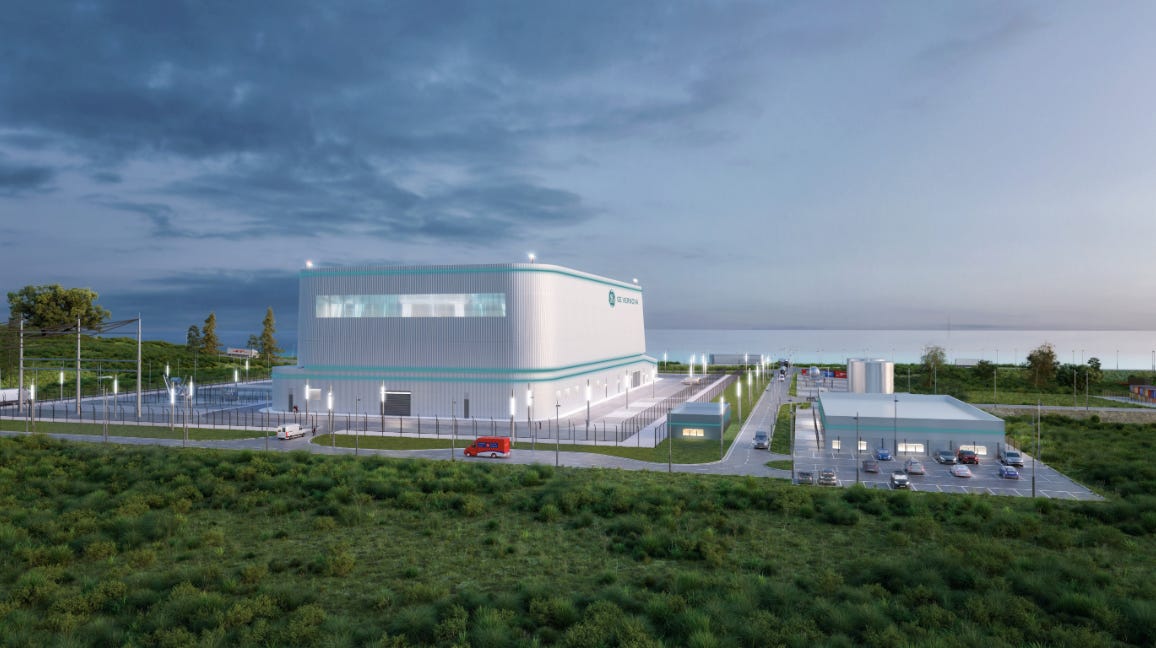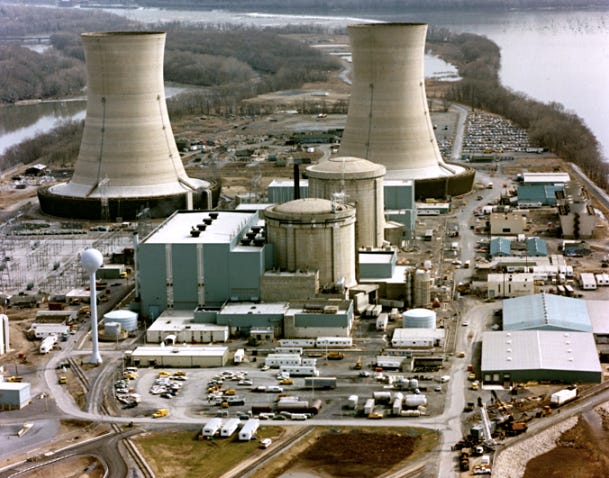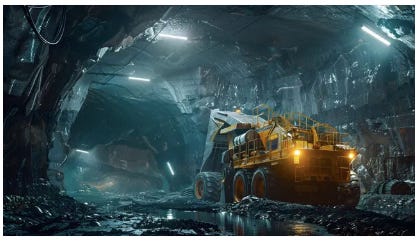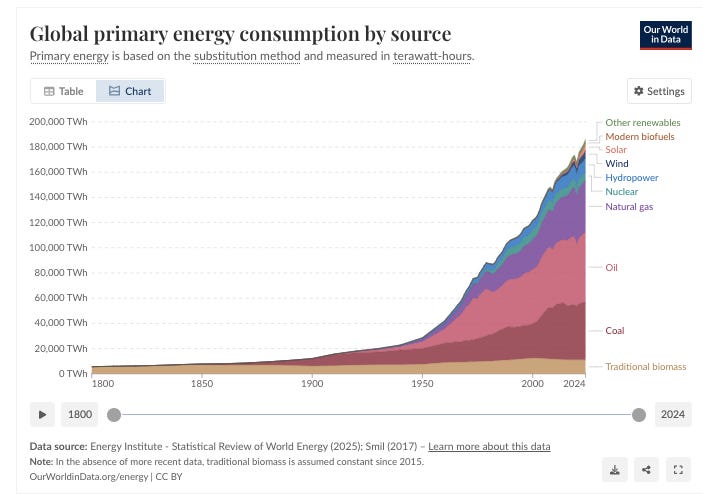Today’s Contemplation: Collapse Cometh CCXX
We’re Saved! A Nuclear Renaissance Is Upon Us, Part 2.
In Part 1 of this multipart Contemplation on the nuclear energy ‘renaissance’ (see: Website Medium, Substack), I argue that energy has been the fundamental driver behind the growth and complexity of human societies, from hunter-gatherer bands to modern industrial civilisation. An expansion that was significantly accelerated with the exploitation of hydrocarbons.
I then trace nuclear energy’s history from its scientific origins to its development for weapons and finally to its rebranding for peaceful purposes. The storyline about peaceful uses was primarily a strategic move by the US who wanted to maintain and expand its technological dominance in the field for economic and geopolitical reasons after the Second World War.
The nuclear industry grew rapidly in the shadow of a narrative aimed at creating great optimism for a nuclear-powered future with electricity “too cheap to meter” and magnificent engineering feats, including inter-galactic space travel. These promises, however, soon collided with economic realities, safety concerns, growing awareness of an unresolved radioactive waste dilemma, and a continuing nuclear weapons programme hidden behind ‘civilian research’ stories.
I finish by arguing that the ‘renaissance’ is being driven by overhyped marketing about nuclear energy being great for the climate (emissions ‘free’), energy security (reduces dependence upon oil imports), long-term sustainability (‘endless’ fuel sources), and a focus upon small modular reactors (SMRs) that are said to address previous concerns regarding cost overruns and construction delays.

If you’re new to my writing, check out this overview.
SMRs
These reactors are still relatively unproven on a commercial scale but are today’s ‘solution’ according to their marketers/cheerleaders. They WILL take humanity to the promised land of ‘clean’ and ‘cheap’ energy, and help fuel perpetual growth on a finite planet.
Cost overruns and missed deadlines for functionality have been major issues for traditional reactors. Whether SMRs can be constructed on time and within proposed budgets has yet to be proven, but the industry is assuring that they will be (and we know we can trust those profitting from their rollout to be honest about such things because, surely, this time will be different). With governments aiming to deploy these technologies as quickly as possible, critics are also raising concerns that weakening oversight could create significant safety risks and further erode public trust.
The issue of waste disposal also remains with these reactors and robust supply chains for some of the necessary fuels (e.g., HALEU from Russia) are questionable given today’s geopolitics. Such hurdles could result in community opposition and possible stalling of projects.
Much of the success of these technologies remains predicated on innovation (as-yet-to-be-hatched chickens), economics (probably a lot of government subsidies and private funding via taxpayers and ballooning debt), and regulations (‘streamlined’ to expedite the process–what could go wrong?).
SMR History
1950s-1980s
Small nuclear reactors are not novel, with early reactor configurations having tended to be small relative to later designs. In fact, the US military experimented early on with compact, mobile reactors for remote bases. And small, pressurised water reactors (PWRs) were developed for use in submarines and aircraft carriers. Despite this start with reactors of limited scale, the industry had its sights set on ever-larger ones to achieve economies of scale and (supposedly) to bring down electricity-user costs (with the claim of ‘energy too cheap to meter’ having been made by some advocates and the media).
1990s-2000s
In the shadow of the Three Mile Island and Chernobyl incidents, public opposition grew and led to the stalling of new plants in most countries. In response, industry marketers began to propose SMRs as the ‘solution’ to potential safety issues. The ‘sales pitch’ emphasised better quality via factory fabrication (because there’s never been a recall on any similarly-produced industrial technologies) and associated cost reductions. Despite these ‘promises’, major projects did not move forward as funding was lacking, low natural gas prices made them less attractive, and previous urgency waned.

2010s-present
Interest in SMRs has intensified with cheerleaders highlighting their ‘carbon-free’ status, reliable base-load generation, domestic security, and geographic flexibility. The US formally began to support the development of SMRs beginning around 2010 and Russia connected its first mobile SMR (Akademik Lomonosov) to its electrical grid in 2020. In 2021, China started up its first design, a high-temperature, gas-cooled SMR (HTR-PM). And despite promises by the industry that they had overcome economic and construction concerns, SMR projects in both the US and Europe have experienced significant cost overruns and delays during the last several years (e.g., see here), bringing into question the promised benefits. Development and massive cheerleading is continuing, nonetheless, with huge amounts of government funding flowing into the industry.
In summary, SMRs have evolved from their early military applications and towards potential commercial deployment with promises of more secure, safer, less expensive, and flexible power generation. They have begun to be used minimally in Russia and China, with North America and Europe taking their first tentative steps with these technologies; yet, concerns and criticisms remain.
Concerns and Criticisms of SMRs
The advocates of SMRs have no problem promoting them as the future of nuclear energy by highlighting their supposed benefits and glossing over or avoiding the hurdles and risks that exist. Despite unanswered questions and a number of worries with respect to their economic viability, regulatory readiness, and waste management, a number of jurisdictions have jumped into contracts to begin their rollout (see: here, here, here, and, here).
Economic Viability
Contrary to the ongoing promises of relatively inexpensive power generation, these technologies have exceedingly high costs with levelised cost of electricity (LCOE) analyses–that tend to underestimate actual user costs–concluding that power generation costs will actually exceed that of ‘renewables’, hydrocarbons, and large reactors (that somehow never met the ‘too-cheap-to-meter’ promises when they were being built and marketed). And, it is estimated by the industry itself that a massive rollout of 30-50+ units would be required before any cost savings would be realised (if ever, given past experience with such promises as a guide)–see here.
Waste
SMRs actually produce a higher waste volume than traditional large units, with some estimates of 2-30 times the amount. They also create new waste streams (e.g., irradiated graphite, reactive salts) that would require new handling and disposal methods as well as significant infrastructure buildout, resulting in additional costs to the pre-construction estimates already made.

Regulations
Established regulations for large reactors do not necessarily address all the issues for smaller ones and this is leading to some delays with a common framework being a ‘work in progress’. And with this being a ‘first-of-a-kind’ rollout, there exist risks in both cost overruns and construction delays–as has happened with all projects to date–with cost reductions being promised with the deployment of the next generation of such reactors; and many of them! (SMR-generated electricity will be cheaper! Any. Moment. Now. We just need to keep investing in and building them!)
Technology and Fuel
Assurances about the viability of this relatively new technology have yet to be proven at scale and are based on (optimistic? overhyped?) projections and not operational evidence. Supply bottlenecks are likely given that the advanced designs require specialised fuel (HALEU) with limited global production. In fact, the majority of the SMR designs have yet to be operational with over 30 of these requiring HALEU fuel that is currently only produced at scale by Russia.
A somewhat measured perspective is beginning to emerge among a limited number of observers regarding SMRs, with the realisation that this technology is not a miracle solution but may play a niche role in power generation (and will tend to be additive to humanity’s energy consumption much like all the other ‘alternatives’ being touted as ‘replacements’ for hydrocarbons). These reactors are not, as claimed, cleaner, less expensive, nor faster to build than traditional large reactors. There continues to exist a very long road to their commercial deployment and very likely will take significantly longer and more money than the promises being thrown about by the industry, connected academics, media, and various politicians.
Of course, such a realisation is not stopping nor slowing the hype surrounding them, nor the money being thrown at them by various governments.

GE Vernova Hitachi BWRX-300
Hitachi’s SMR design (see illustration above) is perhaps the leading candidate for deployment in the West. Its 300 megawatt electrical (mWe) reactor is based upon established boiling water technology and appears cost-competitive.
The technology is relatively simpler (e.g., no pumps are required due to the primary circulation being ‘natural’), with passive safety systems, an estimated 60 year lifespan, and uses commercially available fuel. Several projects have been initiated in North America and Europe (i.e., Ontario, Canada; Tennessee, U.S.; Sweden; Finland).
Hitachi argues that the design is a less expensive (due to reduced material needs) and simplified version of existing boiling water technology, with these SMRs being in their 10th iteration. However, as mentioned above, a significant number of reactors must be deployed to achieve economies of scale and electricity costs are estimated to be significantly more than that of other power sources.
BWRX-300 Criticisms
These particular SMRs face the same issues as that raised above for all designs, especially the realisation of the promises made by its advocates/marketers. Concerns over cost competitiveness, waste streams, regulatory hurdles, and fuel remain (see: this, this, and/or this)–although, as is usual in such circumstances, these matters are being downplayed or ignored for the most part with only the supposed benefits highlighted–this, of course, is Marketing 101: highlight and overhype the benefits exclusively; never, ever, acknowledge nor give the time of day to the litany of risks/dangers and hurdles.
BWRX-300 Fuel
The use of commercially-available fuel (Uranium Dioxide (UO2) pellets; U-235 3.81-4.95% enrichment) is perhaps the greatest ‘advantage’ of this particular design, with the risks and costs minimised as a result of not requiring development and licensing of a new fuel due to the fuel source already being commercialised and readily available. This fuel already has a well-established supply chain, reducing costs and vulnerabilities; especially for nations that produce such fuel (e.g., Canada). Not requiring Higher Assay Low-Enriched Uranium fuel (HALEU; 5-20% enrichment), these BWRX-300 reactors are more commercially viable and expedient–in theory.
Current global uranium ‘identified recoverable’ reserves are estimated to be relatively large at around 5.92 million tonnes (January 2023, at $130/kilogram). It’s important to note that ‘identified recoverable’ refers to resources that are ‘known’ and ‘can’, with a high degree of confidence, be recovered ‘economically’. As with all mined material, such reserve estimates are directly tied to the market price and extraction cost with more difficult-to-reach deposits accessible with higher market prices–and, of course, the economics of this extraction and refinement can change dramatically. [Note: keep in mind that this is a finite resource whose mining is heavily dependent upon industrial machinery and processes that are, in turn, dependent upon hydrocarbon resources; all of which is well into experiencing diminishing returns on investments. And given uranium is located in only certain parts of the world, geopolitics cannot help but play a role in its extraction, production, and supply chains.]
It’s important to acknowledge that even with such known reserves, current extraction and production of uranium does not meet current nuclear reactor demand and is resulting in a supply deficit. Global nuclear power plants require close to 69,000 tonnes of uranium each year but current production consistently falls short of that and depends upon stockpiled reserves and the decommissioning of nuclear weapons to meet demand.
The World Nuclear Association has projected that future demand will grow significantly, especially with many nation’s plans to begin building plants or expand on their number of existing ones. This, of course, will mean that the mining of uranium must expand in tandem; even faster given the growing deficit situation. That new mines take anywhere from 10-15 years to begin production means that a conundrum exists; thus the ‘rush’ to expand mining investment and streamline regulations in several jurisdictions.

A Thought Experiment, With A Bit Of Math…
Leaving aside for the moment a number of obvious hurdles and negative consequences to the ongoing and proposed expansion of the uranium extraction necessary to fuel a significantly larger nuclear power-generation fleet of reactors (e.g., massive ecological destruction, waning diesel fuel supplies to power this enterprise, limited equipment, etc.), the drawdown of a finite resource is, well, finite in nature.
Current global requirements of 69,000 tonnes would take some time to exhaust current identified recoverable reserves of 5.92 million tonnes–approximately 85 years. That’s almost forever. And if one looks at the ‘estimated’ reserves, if the price point doubles to $260/kilogram, there would be 7.94 million tonnes, or 115 years worth of fuel. That’s longer than forever–perhaps even longer should electricity prices continue to increase exponentially and lead to some demand destruction.
Of course, these estimates–that get publicised alongside the many overhyped benefits of such power generation–are modelled projections/scenarios that depend on current drawdown of resources and demand–which is projected to increase significantly as time passes but left out of such prognostications. If we are to be a bit more honest in such modelling, then let’s include increasing drawdown should the world increase uranium use as much as is being proposed–a 3-10x increase in the number of reactors.
If we use the lower increase estimate (3x), rather than 69,000 tonnes required per year we suddenly need closer to 210,000 tonnes bringing reserve lifespan down to 28 (@ $130/kilogram) and 38 (@$260/kilogram) years. Still forever in the eyes of nuclear advocates–mostly because technologies will improve and prices will increase leading to larger reserves…and all the raindrops will be lemon and gum drops.
This optimistic outlook requires a significant increase in the extraction/production of uranium. In fact, some have suggested that an 8-10% annual increase should suffice–a rate rarely achieved, and certainly not for multiple years in a row. Meeting fuel needs, then, depends upon unprecedented extraction rates to increase annually, and for decades upon decades.
So, we ‘invest’ in an expansion of mining (perhaps one of the most destructive industrial enterprises human societies engage in), significantly increasing our drawdown of this resource alongside the drawdown of many other required materials and minerals (because, after all, this enlargement of mining means an equally large increase in all the industrial technologies required to carry out this brilliant enterprise, and the fuel to power this), especially hydrocarbons–embodided carbon anyone?–and thereby eliminate the supposed benefits of nuclear being ‘carbon free’. Ignore this hiccup, however.
And something else that can be ignored is the ecological destruction that would and is beginning to occur in the wake of this ‘solution’, particularly if the need to expand nuclear is much more than the estimated 3x used in this thought experiment (remember, a 10x expansion has been proposed by some); an increase that would drawdown the finite fuel reserves even faster and shorten the lifespan of this wonderful ‘answer’ to humanity’s expansion and energy ‘needs’.
Not even considered in the above is the ‘competition’ from all the other technological ‘solutions’ (e.g., solar photovoltaic, wind turbines, wave energy, hydrogen energy, fusion reactors, etc.) for the material and minerals necessary to carry out this nuclear resurgence as well as continuing expansion of all the other infrastructure to support ever-growing, complex human societies.
Then there’s the waste dilemma associated with nuclear power generation which I will expand on in Part 3 alongside some other considerations regarding nuclear power generation’s promises to support human societies for forever and a day.
It’s important, though, if one wants to remain on the hopium bandwagon of a massive rollout of nuclear power generation via SMRs (or even traditional reactors) to discount such thoughts and projections about the negative side of the ledger and cling to those on the positive side–this overly-optimistic position brought to you by the people profitting from this technological ‘solution’ to our predicaments.

Relevant and related articles:
Valar Atomics Achieves Cold Criticality With Project NOVA | ZeroHedge
The New Nuclear Fever, Debunked | The Tyee
Summary of Greenpeace “Nuclear Reactor Hazards” | Peak Everything, Overshoot, & Collapse
SMR / Gen 4 nuclear reactors less safe & create even more toxic waste
Critics Slam Cost of Ontario SMR Plan, Question Dependence on U.S. Uranium
Slow deployment, safety hazards make SMRs a poor climate solution
World Peak Uranium Production | Peak Everything, Overshoot, & Collapse
World Oil and Gas Demand Could Grow Until 2050, IEA Says
World Fossil Fuels Discoveries and Production
Will oil and gas consumption keep rising through 2050?
Did the “Solution” Solve the Problem, Or Did It Just Make Somebody Rich?
What is going to be my standard WARNING/ADVICE going forward and that I have reiterated in various ways before this:
“Only time will tell how this all unfolds but there’s nothing wrong with preparing for the worst by ‘collapsing now to avoid the rush’ and pursuing self-sufficiency. By this I mean removing as many dependencies on the Matrix as is possible and making do, locally. And if one can do this without negative impacts upon our fragile ecosystems or do so while creating more resilient ecosystems, all the better. Building community (maybe even just household) resilience to as high a level as possible seems prudent given the uncertainties of an unpredictable future. There’s no guarantee it will ensure ‘recovery’ after a significant societal stressor/shock but it should increase the probability of it and that, perhaps, is all we can ‘hope’ for from its pursuit.”
If you have arrived here and get something out of my writing, please consider ordering the trilogy of my ‘fictional’ novel series, Olduvai (PDF files; only $9.99 Canadian), via my website or the link below — the ‘profits’ of which help me to keep my internet presence alive and first book available in print (and is available via various online retailers).
Attempting a new payment system as I am contemplating shutting down my site in the future (given the ever-increasing costs to keep it running).
If you are interested in purchasing any of the 3 books individually or the trilogy, please try the link below indicating which book(s) you are purchasing.
Costs (Canadian dollars): Book 1: $2.99; Book 2: $3.89; Book 3: $3.89
Trilogy: $9.99
Feel free to throw in a ‘tip’ on top of the base cost if you wish; perhaps by paying in U.S. dollars instead of Canadian. Every few cents/dollars helps… https://paypal.me/olduvaitrilogy?country.x=CA&locale.x=en_US
If you do not hear from me within 48 hours or you are having trouble with the system, please email me: olduvaitrilogy@gmail.com.
You can also find a variety of resources, particularly my summary notes for a handful of texts, especially William Catton’s Overshoot and Joseph Tainter’s Collapse of Complex Societies: see here.
